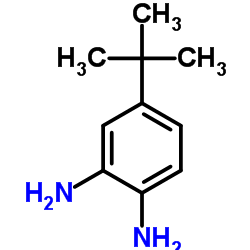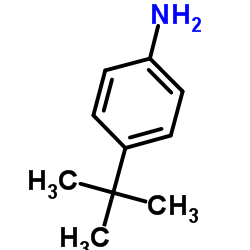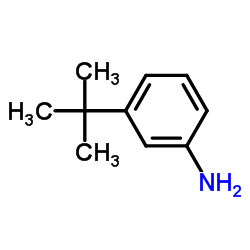4-tert-Butyl-1,2-diaminobenzene
Modify Date: 2025-08-25 00:28:54

4-tert-Butyl-1,2-diaminobenzene structure
|
Common Name | 4-tert-Butyl-1,2-diaminobenzene | ||
|---|---|---|---|---|
| CAS Number | 68176-57-8 | Molecular Weight | 164.247 | |
| Density | 1.0±0.1 g/cm3 | Boiling Point | 290.5±33.0 °C at 760 mmHg | |
| Molecular Formula | C10H16N2 | Melting Point | 98ºC | |
| MSDS | N/A | Flash Point | 153.0±24.9 °C | |
| Name | 4-(tert-Butyl)benzene-1,2-diamine |
|---|---|
| Synonym | More Synonyms |
| Density | 1.0±0.1 g/cm3 |
|---|---|
| Boiling Point | 290.5±33.0 °C at 760 mmHg |
| Melting Point | 98ºC |
| Molecular Formula | C10H16N2 |
| Molecular Weight | 164.247 |
| Flash Point | 153.0±24.9 °C |
| Exact Mass | 164.131348 |
| PSA | 52.04000 |
| LogP | 1.74 |
| Vapour Pressure | 0.0±0.6 mmHg at 25°C |
| Index of Refraction | 1.575 |
| InChIKey | WLOSFXSXVXTKBU-UHFFFAOYSA-N |
| SMILES | CC(C)(C)c1ccc(N)c(N)c1 |
| Storage condition | 2-8°C |
Synonym: Section 2 - COMPOSITION, INFORMATION ON INGREDIENTS
Risk Phrases: 20/21/22 Section 3 - HAZARDS IDENTIFICATION EMERGENCY OVERVIEW
Harmful by inhalation, in contact with skin and if swallowed. Potential Health Effects Eye: May cause eye irritation. Skin: May cause skin irritation. Harmful if absorbed through the skin. Ingestion: Harmful if swallowed. May cause irritation of the digestive tract. Inhalation: Harmful if inhaled. May cause respiratory tract irritation. Chronic: Not available. Section 4 - FIRST AID MEASURES Eyes: Flush eyes with plenty of water for at least 15 minutes, occasionally lifting the upper and lower eyelids. Get medical aid. Skin: Get medical aid. Flush skin with plenty of water for at least 15 minutes while removing contaminated clothing and shoes. Ingestion: Get medical aid. Wash mouth out with water. Inhalation: Remove from exposure and move to fresh air immediately. If not breathing, give artificial respiration. If breathing is difficult, give oxygen. Get medical aid. Notes to Physician: Section 5 - FIRE FIGHTING MEASURES General Information: As in any fire, wear a self-contained breathing apparatus in pressure-demand, MSHA/NIOSH (approved or equivalent), and full protective gear. Extinguishing Media: Use water spray, dry chemical, carbon dioxide, or chemical foam. Section 6 - ACCIDENTAL RELEASE MEASURES General Information: Use proper personal protective equipment as indicated in Section 8. Spills/Leaks: Vacuum or sweep up material and place into a suitable disposal container. Section 7 - HANDLING and STORAGE Handling: Avoid breathing dust, vapor, mist, or gas. Avoid contact with skin and eyes. Storage: Store in a cool, dry place. Store in a tightly closed container. Section 8 - EXPOSURE CONTROLS, PERSONAL PROTECTION Engineering Controls: Use adequate ventilation to keep airborne concentrations low. Exposure Limits CAS# 68176-57-8: Personal Protective Equipment Eyes: Not available. Skin: Wear appropriate protective gloves to prevent skin exposure. Clothing: Wear appropriate protective clothing to prevent skin exposure. Respirators: Follow the OSHA respirator regulations found in 29 CFR 1910.134 or European Standard EN 149. Use a NIOSH/MSHA or European Standard EN 149 approved respirator if exposure limits are exceeded or if irritation or other symptoms are experienced. Section 9 - PHYSICAL AND CHEMICAL PROPERTIES Physical State: Solid Color: purple Odor: Not available. pH: Not available. Vapor Pressure: Not available. Viscosity: Not available. Boiling Point: Not available. Freezing/Melting Point: 96 - 100 deg C Autoignition Temperature: Not available. Flash Point: Not available. Explosion Limits, lower: Not available. Explosion Limits, upper: Not available. Decomposition Temperature: Not available. Solubility in water: Specific Gravity/Density: Molecular Formula: C10H16N2 Molecular Weight: 164 Section 10 - STABILITY AND REACTIVITY Chemical Stability: Not available. Conditions to Avoid: Incompatible materials. Incompatibilities with Other Materials: Oxidizing agents, acids, acid chlorides. Hazardous Decomposition Products: Carbon monoxide, oxides of nitrogen, carbon dioxide. Hazardous Polymerization: Has not been reported Section 11 - TOXICOLOGICAL INFORMATION RTECS#: CAS# 68176-57-8 unlisted. LD50/LC50: Not available. Carcinogenicity: 4-(tert-Butyl)benzene-1,2-diamine - Not listed by ACGIH, IARC, or NTP. Section 12 - ECOLOGICAL INFORMATION Section 13 - DISPOSAL CONSIDERATIONS Dispose of in a manner consistent with federal, state, and local regulations. Section 14 - TRANSPORT INFORMATION IATA Shipping Name: TOXIC SOLID, ORGANIC, N.O.S.* Hazard Class: 6.1 UN Number: 2811 Packing Group: III IMO Shipping Name: TOXIC SOLID, ORGANIC, N.O.S. Hazard Class: 6.1 UN Number: 2811 Packing Group: III RID/ADR Shipping Name: TOXIC SOLID, ORGANIC, N.O.S. Hazard Class: 6.1 UN Number: 2811 Packing group: III Section 15 - REGULATORY INFORMATION European/International Regulations European Labeling in Accordance with EC Directives Hazard Symbols: XN Risk Phrases: R 20/21/22 Harmful by inhalation, in contact with skin and if swallowed. Safety Phrases: S 36/37 Wear suitable protective clothing and gloves. WGK (Water Danger/Protection) CAS# 68176-57-8: No information available. Canada None of the chemicals in this product are listed on the DSL/NDSL list. CAS# 68176-57-8 is not listed on Canada's Ingredient Disclosure List. US FEDERAL TSCA CAS# 68176-57-8 is not listed on the TSCA inventory. It is for research and development use only. SECTION 16 - ADDITIONAL INFORMATION N/A |
| Hazard Codes | Xn |
|---|---|
| Risk Phrases | R20/21/22 |
| Safety Phrases | 26-36/37/39 |
| HS Code | 2921590090 |
| Precursor 9 | |
|---|---|
| DownStream 1 | |
| HS Code | 2921590090 |
|---|---|
| Summary | 2921590090. other aromatic polyamines and their derivatives; salts thereof. VAT:17.0%. Tax rebate rate:13.0%. . MFN tariff:6.5%. General tariff:30.0% |
| MFCD00052695 |
| 4-(2-Methyl-2-propanyl)-1,2-benzenediamine |
| 1,2-Benzenediamine, 4-(1,1-dimethylethyl)- |
| 4-tert-Butylbenzene-1,2-diamine |
| 4-tert-Butyl-1,2-diaminobenzene |
 CAS#:6310-19-6
CAS#:6310-19-6 CAS#:3282-56-2
CAS#:3282-56-2 CAS#:769-92-6
CAS#:769-92-6 CAS#:20330-45-4
CAS#:20330-45-4![Acetamide,N-[4-(1,1-dimethylethyl)-2-nitrophenyl]- Structure](https://image.chemsrc.com/caspic/036/40655-37-6.png) CAS#:40655-37-6
CAS#:40655-37-6 CAS#:142564-53-2
CAS#:142564-53-2 CAS#:38382-35-3
CAS#:38382-35-3 CAS#:6933-55-7
CAS#:6933-55-7 CAS#:5369-19-7
CAS#:5369-19-7 CAS#:99840-59-2
CAS#:99840-59-2
